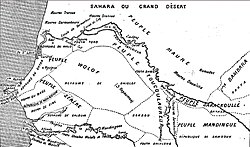There are various ethnic groups in Senegal. According to "CIA World Factbook: Senegal" (2019 estimates), the ethnic groups are Wolof (39%); Fula (probably including the Halpulaar speaking Toucouleur) (27.5%)); Serer group (probably including the Serer Cangin peoples (16%)); Mandinka (4.9%); Jola (4.2%); Soninke (2.4%); other 5.4% (includes Europeans and persons of Lebanese descent), and other minor ethnic groups like the Bassari, Maures or (Naarkajors)).[1] Many subgroups of those can be further distinguished, based on religion, location and language. According to one 2005 estimate, there are at least twenty distinguishable groups of largely varying size.[2]

A few Bassari and Bedick live in the hills in eastern Senegal around Kédougou. These are subgroups of the Tenda, same as the Coniagui and the Badiaranké.
Europeans and descendants of Lebanese migrants are fairly numerous in urban centres in Senegal, about 50,000. Most of the Lebanese originate from the Southern Lebanese city of Tyre, which is known as "Little West Africa" and has a main promenade that is called "Avenue du Senegal".[11]
There are also many other smaller representations of other ethnic groups in Senegal, including the Khassonké, the Lawbe and the Papel.
There are also small Chinese and Vietnamese migrant communities.
The predominant ethnic groups in Senegal share a common cultural background so that, apart from their languages that also have many similarities, there are no effective cultural barriers between them. [dubious – discuss] This is why marriage between ethnic groups in Senegal is so common.[original research?]
The Serer people who have vehemently resisted Islamization for almost a thousand years in order to preserve their religious beliefs and way of life have been historically persecuted by the Muslims.[12][13][14][15] Since the 20th century, their religious and ethnic persecution is less visible. However, they are now viewed as the object of scorn and prejudice.[16][17]
{{cite book}}: |journal= ignored (help)